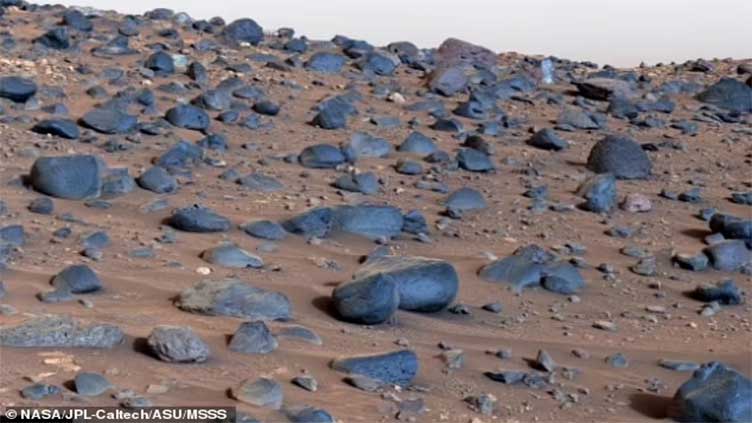Clearest view of Mars shows blue rocks littering Martian landscape

Technology
Nasa has released the clearest view of Mars yet
(Web Desk) - Nasa has released the clearest view of Mars yet, showing stunning blue rocks littering the Martian landscape.
The footage, captured by the Perseverance rover as it continues to explore the Red Planet, also revealed 'first of its kind' geological formation resting atop the dried remains of an ancient lakebed.
Dark blue, jagged boulders of volcanic basalt were spotted surrounding the speckled white rock, which was found to have a mineral composition unlike anything NASA has ever seen before on Mars.
Perseverance — a car-sized, remote-controlled mobile lab — has been exploring the dusty basin of this asteroid impact site, dubbed Jezero crater, since February 2021.
Jezero was once flowing with water about 3.7 billion years ago, with evidence of a 'paleolake' and a long, lost river delta within the rim of this 28-mile-diameter crater.
Fine-grained sand and mud of exactly the consistency known to preserve fossils on Earth were ferried into Jezero by these rivers: fine clay that Perseverance had been sent to explore in NASA's belief that this crater may have once supported alien life.
'Every once in a while, you'll just see some strange thing in the Martian landscape,' as one NASA planetary geologist Dr Katie Stack Morgan of NASA's Jet Propulsion Laboratory put it, 'and the team is like, 'Oh, let's go over there!''
Most of the bluish-black rocks seen on the surface of Mars, like those on 'Mount Washburn,' are volcanic basalt.
'Mars is composed mostly of rocks similar to terrestrial basalts called tholeiites,' according to planetologist and geophysicist Dr G. Jeffrey Taylor at the University of Hawaii, 'which make up most oceanic islands, mid-ocean ridges, and the seafloor beneath sediments [on Earth].'
But the white, speckled rock that stood out in the middle of this basalt caught NASA's Perseverance team by surprise.
'This was like the textbook definition of [chasing] the bright, shiny thing,' Dr Stack Morgan said, 'because it was so bright and white.'
Perseverance captured the photo with its Mastcam-Z, a three-dimensional set of cameras perched at human eye-level on a six-and-a-half foot mast atop the rover.
Mastcam-Z offers a 2-megapixel quality, 'similar to that of a consumer digital camera,' according to the US space agencies specs, which accounts for the crisp clear image of this rock formation.
The camera's 3D images offer a resolution of 0.0059 inches per pixel up close, and 0.3 inches per pixel at maximum zoom.
NASA named the novel, arresting white rock, which measures about 18 inches wide and 14 inches tall, 'Atoko Point' after an over 8,000-foot cliff in the Grand Canyon.
But it was the explorer robot's full suite of chemical analysis and geological tools, SuperCam, that helped to determine just what a unique discovery the 'Atoko Point' rock actually was.
SuperCam's two lasers and four spectrometers found enough of the mineral feldspar to confirm that this white rock was Anorthosite, a type of rock that has long been theorized but never before documented as existing on Mars, Dr Stack Morgan noted.
Like basalts, anorthosites are also volcanic rocks, but muck more rich in silica compounds, suggesting that this 'Atoko Point' stone may have emerged from deeper underground that the rocks surrounding it.
Further examples of anorthosite could help determine if 'Atoko Point' had been dragged into the crater via its ancient rivers or was formed underground by lava, and perhaps pulled up by the impact that created Jezero crater billions of years ago.
'Seeing a rock like Atoko Point is one of these hints that, 'Yes, we do have anorthosites on Mars,'' NASA JPL's Dr Stack Morgan told Mashable. 'And this might be a sampling of that lower crust material.'
The NASA JPL researcher, the deputy project scientist of NASA's Mars 2020 mission that launched Perseverance years ago, said she hopes more finds like the rock reveal details on the what's now under the surface of Mars and how the planet formed.
'If we see it later on in the context of other rocks, it can give us a sense for how the earliest crust of Mars kind of came to be.'



